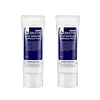What's inside
What's inside
 Key Ingredients
Key Ingredients

 Benefits
Benefits

 Ingredients Side-by-side
Ingredients Side-by-side

Galactomyces Ferment Filtrate
HumectantWater
Skin ConditioningGlycerin
HumectantGlycereth-26
HumectantSorbitol
HumectantBetaine
HumectantCarbomer
Emulsion StabilisingArginine
MaskingSh-Oligopeptide-1
Skin ConditioningSh-Polypeptide-11
Sh-Oligopeptide-2
Skin ConditioningCopper Tripeptide-1
Skin ConditioningMadecassoside
AntioxidantMadecassic Acid
Skin ConditioningAsiaticoside
AntioxidantAsiatic Acid
Skin ConditioningDextrin
AbsorbentBeta-Glucan
Skin ConditioningXanthan Gum
EmulsifyingPanthenol
Skin ConditioningAllantoin
Skin ConditioningDipotassium Glycyrrhizate
HumectantEthylhexylglycerin
Skin ConditioningPropanediol
SolventChamaecyparis Obtusa Branch/Leaf Extract
Humectant1,2-Hexanediol
Skin ConditioningGalactomyces Ferment Filtrate, Water, Glycerin, Glycereth-26, Sorbitol, Betaine, Carbomer, Arginine, Sh-Oligopeptide-1, Sh-Polypeptide-11, Sh-Oligopeptide-2, Copper Tripeptide-1, Madecassoside, Madecassic Acid, Asiaticoside, Asiatic Acid, Dextrin, Beta-Glucan, Xanthan Gum, Panthenol, Allantoin, Dipotassium Glycyrrhizate, Ethylhexylglycerin, Propanediol, Chamaecyparis Obtusa Branch/Leaf Extract, 1,2-Hexanediol
Galactomyces Ferment Filtrate 95.13%
HumectantPentylene Glycol
Skin ConditioningNiacinamide 2%
SmoothingMadecassoside
AntioxidantMadecassic Acid
Skin ConditioningAsiaticoside
AntioxidantAsiatic Acid
Skin ConditioningOligopeptide-1
Skin ConditioningSh-Octapeptide-4
AntioxidantSh-Decapeptide-7
AntioxidantSh-Oligopeptide-9
HumectantOligopeptide-28
AntioxidantSh-Pentapeptide-19
Skin ConditioningHeptyl Glucoside
Dipotassium Glycyrrhizate
HumectantAllantoin
Skin ConditioningAdenosine 0.04%
Skin ConditioningCeramide AP
Skin Conditioning1,2-Hexanediol
Skin ConditioningGalactomyces Ferment Filtrate 95.13%, Pentylene Glycol, Niacinamide 2%, Madecassoside, Madecassic Acid, Asiaticoside, Asiatic Acid, Oligopeptide-1, Sh-Octapeptide-4, Sh-Decapeptide-7, Sh-Oligopeptide-9, Oligopeptide-28, Sh-Pentapeptide-19, Heptyl Glucoside, Dipotassium Glycyrrhizate, Allantoin, Adenosine 0.04%, Ceramide AP, 1,2-Hexanediol
 Reviews
Reviews

Ingredients Explained
These ingredients are found in both products.
Ingredients higher up in an ingredient list are typically present in a larger amount.
1,2-Hexanediol is a synthetic liquid and another multi-functional powerhouse.
It is a:
- Humectant, drawing moisture into the skin
- Emollient, helping to soften skin
- Solvent, dispersing and stabilizing formulas
- Preservative booster, enhancing the antimicrobial activity of other preservatives
Allantoin is a soothing ingredient known for its protective and moisturizingg properties. Because of this, it is often added to products with strong active ingredients.
Studies show higher concentrations of this ingredient can promote wound healing.
Though it can be derived from the comfrey plant, allantoin is produced synthetically for cosmetic products to ensure purity.
Learn more about AllantoinAsiatic Acid is a major component of Centella Asiatica Extract. It has wound-healing, anti-inflammatory, and antioxidant properties.
Studies show Asiatic Acid is able to block the pathway for skin inflammation receptors, helping to soothe skin.
As an antioxidant, asiatic acid helps protect our skin against damaging environmental factors.
Learn more about Asiatic AcidAsiaticoside comes from the super popular skin-soothing ingredient, Centella asiatica. It is one of four active compounds found in the extract of Centella Asiatica.
Asiaticoside is an antioxidant and helps with wound healing. It has been shown to increase antioxidant activity during the wound healing process.
Dipotassium Glycyrrhizate comes from licorice root.
Extracts of licorice have demonstrated to have antibacterial, anti‐inflammatory, antiviral, antioxidant properties.
One component, glabridin, has extra potent antioxidant and soothing properties. It has also been found to block pigmentation from UVB rays in guinea pigs.
Licorice Root also contains a flavonoid. Flavonoids are a natural substance from in plants. Flavonoids also have antioxidant properties.
Another component, glycyrrhizin, has been found to have anti-inflammatory and antimicrobial benefits. This may make licorice root extract effective at treating acne. However, more research is needed to support this.
Liquiritin is one of the flavone compounds found in licorice. It has been found to help lighten skin by preventing tyrosinase from reacting with tyrosine. When the two react, protein is converted to melanin. Melanin is the substance in your body that gives your features pigmentation.
Licorice root is native to Southern Europe and Asia. It has been used in traditional Chinese medicine to help with respiratory issues.
Learn more about Dipotassium GlycyrrhizateGalactomyces Ferment Filtrate (GFF) is a yeast traditionally used to make the Japanese alcoholic beverage, sake.
GFF has moisturizing and antioxidant properties.
Studies show GFF improves our skin's natural moisturizing factors (NMF). Our NMF consists of many components that naturally moisturize our skin. Having healthy NMF keeps our skin plump, protected, and hydrated.
This ingredient tells our skin to create more filaggrin, an important component for NMF.
Filaggrin gathers all the structural proteins in our outer layer of skin and creates a tight barrier, helping to protect our skin against allergens and bacteria. This also helps prevent moisture loss.
Thanks to its antioxidant properties, GFF also protects our skin against oxidative stress and UV induced inflammation.
One study found GFF helped regulate sebum (oil) production and keratin in participants.
GFF may not be fungal-acne safe. We recommend speaking with a professional if you have concerns.
Many components of sake, such as GFF, are studied for their anti-aging benefits today. This is because sake brewers are known to have youthful hands.
Learn more about Galactomyces Ferment FiltrateMadecassic Acid is a major component of Centella Asiatica Extract. It has anti-inflammatory and antioxidant properties.
It is a triterpenoid, meaning it naturally acts as an antioxidant. Antioxidants protect your skin against damage from environmental factors such as pollution and UV.
Studies show Madecassic Acid helps soothe the skin due to its ability to block inflammation pathways.
Learn more about Madecassic AcidMadecassoside comes from the super popular skin-soothing ingredient, Centella asiatica. It is one of four active compounds found in the extract of Centella Asiatica.
Madecassoside has antioxidant, anti-inflammatory, and hydrating properties. It contains fatty acids, amino acids, beta-carotene, and phytochemicals.
One study found using Madecassoside with ascorbic acid helped reduce the signs of aging and improved skin hydration.
Learn more about Madecassoside